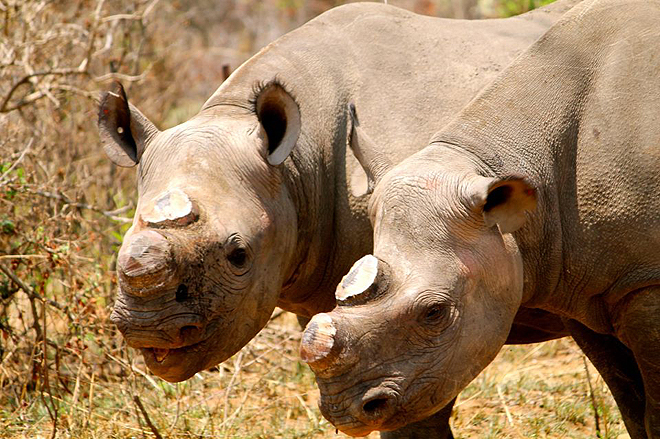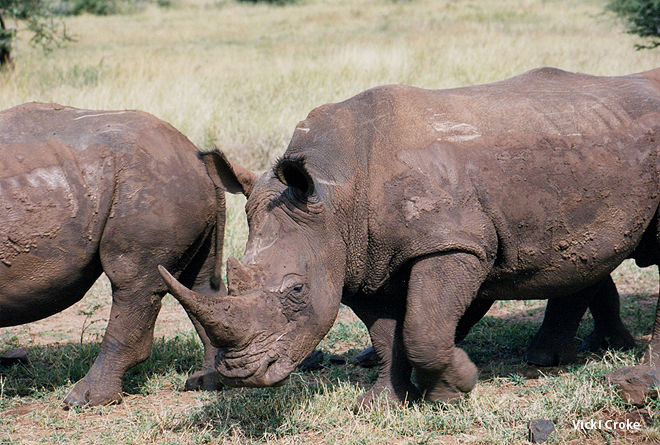Dehorning Rhinos: A Whole Country Is Banking On It
Does dehorning rhinos keep them safe from poachers? Namibia tries a controversial program.
By Vicki Croke
Will surgically removing the most iconic rhino body part—the horn—keep the animals safe from poachers?
For this surprisingly complicated issue, we’re about to get an answer in a big way.
Photo: Courtesy of:
The Perfect World
Foundation.

Smaller-scale dehorning programs have been tried in the past, but now an entire country is launching a sweeping campaign to dehorn every rhino within its borders.
Namibia, which contains the world’s largest concentration of critically endangered black rhinos, has begun to surgically remove horns from the rhinos in national parks in an effort to save the animals from poachers. On average, two African rhinos are killed by poachers every day, according to the conservation group African Wildlife Foundation.
Namibia’s solution, according to Bloomberg, is to take away the part of the rhino that poachers covet:
Namibia has one of the world’s largest populations of black rhinos, which are under threat from poachers who sell their horns on the black market mainly for use in Chinese medicine, according to the World Wildlife Fund. About 1,750 black rhinos live in Namibia, out of a global population of 4,800, and 469 white rhinos, according to Save The Rhino and WWF.
“Rhino poaching has risen dramatically, that is why we have to take some immediate and drastic measures,” Deputy Environment Minister Pohamba Shifeta said [Monday] by phone from the capital, Windhoek.
The program is not without controversy. There is disagreement about whether dehorning is safe or effective; whether it affects the animals’ reproductive success; if it can be sustained over time since the horn, which is made of the same substance as hair and nails, grows back; and finally, if the government sells the trimmed horn, would that in fact promote wildlife trafficking?
According to the World Wildlife Fund, since rhino horn grows back at a rate of about three to four inches a year, that means that the procedure, with its inherent risks from sedation, would have to be repeated on each rhino regularly, perhaps every four years.

And some people question whether dehorning even keeps the poachers away. The conservation group Save the Rhino says dehorning results have been mixed. Poachers may still kill dehorned rhino—to collect the little bit of horn left after the procedure, or out of revenge, or because they don’t even know the rhino they are tracking has no horn until after they’ve killed the animal.
There are several instances of rhino dehorning programs that appear to have been successful, but the Save the Rhino also points out those that have not:
There are numerous cases where dehorning has proved insufficient to prevent rhinos from falling victim to poachers. For example, in Hwange National Park, Zimbabwe during the early 1990s, the majority of dehorned rhinos were killed just 12-18 months after being dehorned. In Zimbabwe’s Save Valley Conservancy, six newly dehorned rhinos were poached during January-August 2011 (one rhino was killed within 24 hours and another within five days of being dehorned).
…So why do poachers continue to target hornless rhinos? This is often attributed to the stub of horn that is left after removal. … although poaching is made less profitable, the sad reality is that poachers will still kill for a horn stub due to its high value.
Poachers may also kill dehorned rhinos out of vengeance. In Hwange NP, it was thought that poachers killed dehorned rhinos, to avoid tracking them again. Furthermore, if there is thick bush or hilly terrain poachers may not see if the rhino has an intact horn prior to shooting.
Save the Rhino maintains that for dehorning programs to work, they must be bolstered by anti-poaching efforts. Bloomberg reports that the Namibian government says it is, in fact, “creating a 300-strong anti-poaching unit made up of members of law enforcement agencies that will patrol in poorly policed national parks and it’s planning to deploy surveillance drones.”
On the basic question of whether dehorning can adversely affect rhinos physically or behaviorally, at least one study suggested that de-horned mother rhinos cannot protect their babies as effectively. But in the face of such catastrophic poaching, that may be a reasonable sacrifice.
And, as an article in Real Clear Science last year, by writer Chelsea Harvey, indicated, there are scientific disagreements even on this point:
“Dehorning is not a significant issue for rhinos in terms of behavior and reproductive health,” Du Toit [Raoul du Toit, director of the Lowveld Rhino Trust in Zimbabwe] said. “The evolutionary advantages of possessing a horn were developed before AK-47s were invented and are not such advantages now.” Research published in 2013 by Du Toit and Natasha Anderson, rhino coordinator for the Lowveld Rhino Trust, challenged some of the supposed consequences of dehorning.
There are also concerns about the fact that the government intends to stockpile and eventually sell the rhino horn. That’s if they can get permission to do so from CITES, The United Nations’ Convention on International Trade in Endangered Species.

But does selling illegal wildlife products worsen the problem? “It is irresponsible to sell horn,” Dr. Paula Kahumbu, CEO of WildlifeDirect, and an influential voice for conservation in Kenya, said via email. “Not only does it stoke demand and therefore threaten all rhinos, but it is a cruel exploitation of vulnerable ignorant people who think horn will cure them of cancer.”
That’s been the thinking that has driven some countries, including the United States, to burn their stockpiles of ivory. In a New York Times article last year, about the announcement that the US Fish and Wildlife Service would destroy six tons of illegal African elephant ivory, officials made clear that selling stockpiled ivory, rhino horn, or tiger bone, worked against conservation:
Daniel M. Ashe, the director of the Fish and Wildlife Service, said that reintroducing the government’s stock of ivory into the legal market was not a viable option because small sales had been shown to stimulate demand, not satiate it. Officials also said adding to the supply would make it harder to identify and prosecute illegal trade.
At least two other Namibian wildlife policies have sparked controversy recently.
Back in January, a hunting permit the government issued to shoot a black rhino was auctioned off at the Dallas Safari Club for $350,000. (The government issues five such kill permits a year.) According to a Reuters story,
A permit to hunt a black rhino in Namibia sold for $350,000 at an auction in Dallas on Saturday with proceeds going to protect the endangered animals despite protests from animal rights groups that saw the sale as immoral conservation.
The license allows for the killing of a single, post-breeding bull, with Namibian wildlife officials on hand for the hunt to make sure an appropriate animal is selected.
Also, according to The International Business Times:
Namibia sparked controversy in July 2014 after announcing it would issue hunting permits to allow people to shoot at desert elephants to solve human-animal conflict.
According to campaigners, worldwide 35,000 elephants and 1,000 rhinos are killed each year through ivory and rhino horn poaching, and the animals could be extinct in 20 years.

4 Responses to “Dehorning Rhinos: A Whole Country Is Banking On It”
Something has to be done save the rhino. It has to be made as difficult and as expensive as possible for the poachers, with little return for them.
I also feel for those who may feel pushed into poaching, in these countries, for example, they live in poverty. Alternative ways to make a living, with a reasonable income, should be provided, like protecting nature and maybe helping in tourism, should be done.
hi don’t kill the rhino
I recently saw a video, taken by a park ranger, of a dehorned rhino being killed by a hippo. They took his horn, leaving him defenseless, then didn’t save him from the hippo-of which there are plenty.
If they’re going to take the rhino’s horn, they MUST also protect the rhino from other wildlife, not just poachers.
Rhino horns grow back, yes. But I’m curious if, biologically, it would prevent any growth at all to disbud baby rhinos, like baby goats and lambs are disbudded. Disbudding, rather than dehorning, involves burning the horn base to prevent any growth ever.
Is it possible to do that with a rhino?
Comments are closed.